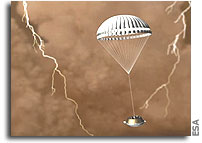Latest Results from Huygens 21 January 2005

http://images.spaceref.com/news/huygens.7.jpg
One week after its successful landing on the surface of Titan scientists have given more details on the observations made by the probe.
General Information
- Liquid methane on surface of Titan as opposed to water on Earth
- Rocks on Titan constitute dirty ice as opposed to silcate rocks found on Earth
- Surface temperature confirmed at 94 K
- Results based on information for all instruments.
- 22 000 km per hour to 1400 km per hour in 3 minutes on atmosphere entry
- Probe underwent a soft landing
- Descent through atmosphere bumpier than expected
Ground based Radio Observations
- VLBI observations have returned the data that was lost on channel A, although it will take some months to analyse
Event Times
Confirmed mission event times in UTC 14 January 2005 in terms of hours:minutes:seconds
- 04:41:19 Probe wake up
- 09:05:56 Interface altitude
- 09:10:24 Main parachutre
- 09:25:21 Secondary parachute
- 10:20:00 Radio telescope signal received at Green Bank
- 11:38:11 Landing
- 12:50:24 Cassini signal detection ended, giving 72 minutes data on surface.
- 15:55:xx Parkes radio telescope lost communications
DISR
- Surface ridge around 100m tall
- Channels are evidence of rain
- Dark material are photochemical smog deposits
- Ridges made of frozen hard water ice
- Some evidence for fluid flow in the form of methane
- Evidence for Earth like processes such as precipitation, but with different materials
- Possibility of rainfall relatively recently
GCMS
- Gases like Argon are not present on Titan
- Methane present because of the low temperature
- Oxygen is tied up in frozen water preventing formation of carbon dioxide
- Methane atmosphere is a very primative atmosphere, comparably to the Earth in its very early history
- Methane must condense on the surface due to the low temperatures
- Must be a methane source on Titan to keep replenishing the atmosphere
- In upper atmosphere nitrogen is dominant gas and in lower atmosphere methane is present in higher abundances (this change is similar to the change in water vapour in the Earth’s atmosphere)
- On surface nitrogen levels remained constant
- Methane levels changes over time on the surface implying a release of methane. The origin is probably liquid methane located just below the surface.
SSP
- Tests have been done in labs to recreate the impact measurements derived from the penetrometer
- Test done using a sand of fine glass particles with a thin crust added and this has produced a comparable result
- Accelerometer measurements suggest probe settled 10 to 15 cm into the surface
- Heat from instruments has evaporated liquid methane in the soil and released on the surface as methane gas









